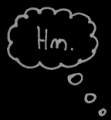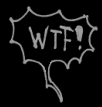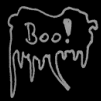Stick Figure Tutorial
II
(Double Eye) |
>> Introduction
Another Stick Figure Tutorial?! Yes. Even though you might think that after the previous tutorial drawing Stick Figures is REALLY something EVERYONE can do, there are certain additional guidelines which make Stick Figures look like advanced "real" Stick Figures. This second part will teach you the advanced basics of drawing the simplest and - at the same time - most difficult style in the wor-, no, universe (if intelligent aliens exist, even they would have problems drawing Stick Figures!).
|
>> Introduction II
If you have paid attention in the last tutorial, you should be a bit more than a Stick Figure drawing newbie by now. I mean, if you draw Stick Figures now, most other "normal" beings out there won't notice a difference between your Stick Figures and mine. Well, actually, now that I think about it, they WILL notice a difference (my Stick Figures are superior). But anyway, this tutorial will teach you expert basics about drawing Stick Figures.
And by Stick Figures I mean those little drawings with a circle and sticks that look like arms and legs. And a body.
If you can't draw what I've taught you in the last tutorial, you now REALLY aren't supposed to draw Stick Figures. Go and play with flies.
Now, I'm gonna be really brave today. I will tell you a secret that has been given to me by my grandfather, who had received it by his grandfather, who also got told this secret by his grandfather (and so on). Please, in case you're reading this while standing (for whatever reason), sit down now because what I'm going to tell you will hit your brain like a baseball bat (when swung against you and not lying around in the basement).
|
>> The Ancient Hat Drawing Technique
Hello? Still with me? Good! You have some potential (not really, but a teacher's gotta throw some bones to keep their pupils biting, uh, reading).
Anyway, I'm really getting myself into problems by telling you this, but I better tell you now before I die and take this ancient technique with me into my grave.
Now, I need you to relax and read every word very, very, very carefully. I'm not going to explain it twice. Well, you can read it twice. But whatever.
To draw a hat using the Ancient Hat Drawing Technique you first have to close your eyes and imagine wearing the following hat:

This will also be the hat that you - yes, YOU! - are going to draw now. Take an empty sheet of paper and a pencil. Your drawing should now look like this:

So far so good. Don't break your concentration! Take a pencil into your hand (I really suppose you have only ONE hand you're drawing with). Take a look outside the window (if you don't have a window, a photography of a garden with flowers will do) and take a deep breath. If you kept doing the previous steps precisely the way I described them, your drawing should now look like this:

Okay, remember to breath in and out. Now we're going to draw two lines. Be careful though, the angle between them has to be exactly 40°!

Now connect the upper edges of the two lines with a curved line. Like this:

Draw the same curved line, connecting both upper edges of the two lines with the 40° angle between them - but this time flip it vertically, resulting in the top of the hat! Example:

If your drawing doesn't look like the picture above, stand up and turn around three times, still imagining to have the hat (shown at the beginning of the Ancient Hat Drawing Technique part) on your head. This should comfort my grandfathers's dignity. If your drawing looks like this:

Then please go back to the first part of this tutorial. Thank you. In case your drawing looks like the picture above the picture above, you may continue reading. We now draw a curved line which connects the lower edges of the first two lines with the 40° angle between them, with the curve pointing down. Like this:

The following step is the most difficult one! You will now perform an oval circle (an ellipse, actually), that basically has the same shape as the top of the hat, only a bit larger. The cylinder-esque-ish-like form you just drew should be "standing" on the shape you're going to add. Take a look:

Good! Hat looks ready to be used. Now, if you want a Stick Figure to actually wear the hat, you have to first draw the hat, then draw the head of the stick figure below it, but be aware that only a bit more than half of the head is actually seen (the rest of the head is hidden underneath the hat). See here:

Your drawing is now reason enough to celebrate! Congratulations! Now practice the Ancient Hat Drawing Technique until you master it and you'll be drawing hats in seconds! Also, show this technique to your children and your children's children and - if you're still not dead by then - also show it to your children's children's children - and keep the technique alive!
|
>> Stick Figures Can Talk!
- or -
>> Speech Bubbles Done Rather Expertly!
Your Stick Figures are able to talk, but you have to provide them with the proper tools: Speech bubbles.
What the vocal chords are for us, the speech bubbles for Stick Figures represent.
("Le Stique Figure" by Francois Pont D'Avignon, Page 152)
Here are examples of wrong speech bubbles.

Outrageous! Ludicrous!
Now let me show you a perfect speech bubble.

Notice how the arrow that leads to the talking Stick Figure is clear and pointy, the actual speech bubble round and shiney. Take care of your speech bubbles. They give your Stick Figures a much better voice.
To further increase the detail of a given "voice", you can add bubble diversity. Especially, when the Stick Figure is not talking at all, but thinking! Here is a thought bubble example:

The arrow is gone! It gets replaced by small circles, that kind of represent the "steam" that the Stick Figure's brain emits. The thought bubble itself is not a perfect circle, instead it is "cloudy", "fluffy", you could say it looks like the body of a sheep, which makes even more sense since most people think of sheep when trying to sleep.
Anyway, further bubble varieties include:
Yelling Bubble (for angry Stick Figures).

Slimey Bubble (for dead Stick Figures).

Square Bubble (for mechanic Stick Figures).

Basically, the bubble can depend on the Stick Figure and its character! Like, if your Stick Figure is a total maniac its speech bubble could be on fire, or something.
|
>> Run Like Hell!
If your Stick Figures ever find themselves in danger (like a huge fire), they should have the ability to PROPERLY run away. Not like this:

Pretty much not like this:

And not like this either:

Actually, it should look something like this:

Hm, oh well, the Stick Figure just ran away so fast it wasn't even on the picture anymore! Oh, this just in! We are receiving live images of how the Stick Figure runs away from the fire (approximately 15.3 kilometers away already):

Oooh, boy! That is fast!
|
>> Fingers
Do Stick Figures have fingers? Of course they do! How else could they point and laugh at your unbelievably sucky speech bubble drawing skills? But, you have to consider the almost non-existent muscles Stick Figures have, thus they can only carry three fingers on each hand. If they had more fingers they wouldn't be able to run away from dangerous fire anymore (which is sad).
You can use fingers in poses (see Stick Figure Tutorial I).
Like, pointing:

Insulting:

Giving up hope:

Ordering pizza:

Obeying Gothazod's 37th Rule:

And so on and so forth! If you don't want to use fingers for your Stick Figures, maybe try to think of yourself when typing on your keyboard. Could you do that without fingers? COULD YOU?
... Show me.
|
>> Movement
When Stick Figures move you have to think of a photography. Like, when someone passes you at 100 miles per hour and you take a photo of him (or her) you will see that his body is "deformed" (unless you have a very expensive sports camera that can shoot crystal clear photos of light speed space shuttles) and the body leaves a kind of trail where it comes from. Your Stick Figures use the same technique! But first, a bad example.
The following picture looks like the Stick Figure's back side is shining.

How can we improve this? Well, first of all, the lines are completely wrong, so you should remove them all. If you want to show that the Stick Figure is walking slowly, just repeat the shape of the head behind it twice, but make the lines always go smaller. Here's how:

Now, if you want to show that (even in that slow-walking-position) the Stick Figure actually moves faster than the speed of light, you have to add a "guide" line to show the one who's watching where the Stick Figure is coming from (this is the trail in the photograph). There should be two parallel lines, and in the approximate height of the head add the two "shape" lines. Take a look:

Now, this looks kind of weird (even to you probably). Maybe we should add a proper running pose.

This just in! The Stick Figure who ran away from the fire is still running away from the fire and shows us that when Stick Figures run real fast shape lines aren't really necessary!

Anyway! Now try it out yourself without my help (I'm sure you'll be back any second).
|
>> Final Thought
SFAMA? You? HA! Not even close. Only practice leads to success, and you OBVIOUSLY don't have practice or else you wouldn't be reading this, would you? WOULD YOU?
Okay. Well, in YOUR case you're probably just pretty bored then.
Either way, it will take another 15 years for you to succeed in the techniques described in the second part of this epic, revolutionary, outstanding Stick Figure Tutorial. Better start practicing now.
YES, FIFTEEN YEARS. Not fifteen minutes. Sheesh, people nowadays.
|
|